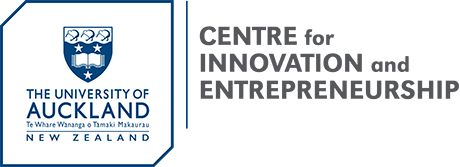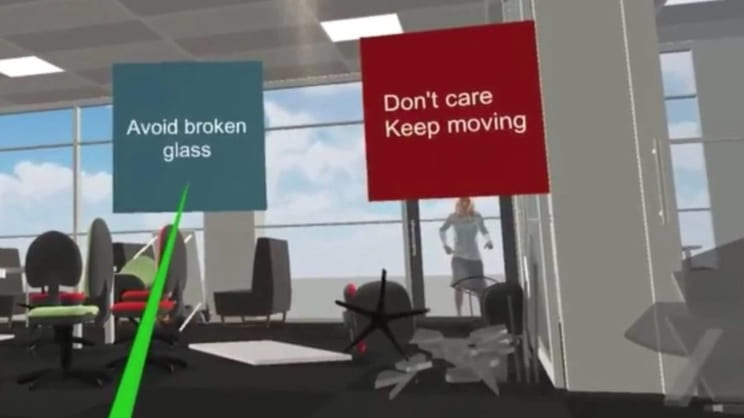
NEWSROOM
VR game simulates quake to help children stay safe
A virtual reality game that could save lives during an earthquake has emerged from the Centre for Innovation and Entrepreneurship’s Velocity programme.
The result of a collaboration between experts in education, computer science and engineering, the game simulates what might happen in an ordinary school classroom during and after an earthquake.
Aimed at Year 7, 8 and 9 students, the five to ten-minute game gives players different pathways and right and wrong options, with the overall goal of helping them stay as safe as possible should the real thing happen.
One of the project partners, engineering PhD student Zhenan Feng, says the visual landscape of the game is based on an actual building in Ormiston Junior College in Flatbush, East Auckland.
“I wanted to design the game realistically, so I took photos and made a model of a particular building at Ormiston, and included the sound of a real earthquake.”
He later trialled the game with 150 students from the school and there was a significant improvement in the students’ knowledge about what to do in an earthquake after playing it.
Some students had thought running outside to escape being crushed was a good idea, for example, whereas it’s best to get under something solid like a desk and stay inside until the shaking stops.
“Our team includes myself, my main supervisor, Dr Vicente Gonzalez, and my co-supervisors Professor Robert Amor from the Department of Computer Science and Carol Mutch, an Associate Professor of Critical Studies in Education. This makes it a multi-disciplinary project, bringing together computer science, civil engineering, human behaviour, and education. We all bring different perspectives, research methods, insights, materials and resources, which I see as very beneficial in the shaping of our project.
“Dr Gonzalez came up with this idea three years ago – VR has unique features that make it possible to study human behaviour under extreme conditions, and also provides opportunities to train people in virtual environments that are very close to the real world. Although VR has become popular in recent years, we still need to convince people that this technology can bring something new to traditional training environments.
“Our original prototype has been tested in Auckland City Hospital in 2017. We’ve since developed it further and are planning to test it with various types of people, not only for effectiveness but also for applicability.
The game, called the Editable Immersive Virtual Reality Serious Game, won a prize in the Velocity Innovation Challenge, giving the team encouragement to pursue their venture idea further. The next step for the project is to develop a business case for the game’s launch to market, with the team hoping to take out the big prize at the Velocity $100k Challenge finals.
Says Zhenan: “We don’t have too much experience with commercialisation, but participating in Velocity will help us add value and an entrepreneurial edge. For us, it’s less about winning the prize, and more about recognition for the quality of this project and its potential. We see this game being globally attractive, with a range of possible emergency situations, users and locations; including offices and outdoor environments.”
Stuff: Earthquake simulation game could save children’s lives


A virtual reality game that could save lives during an earthquake has emerged from the Centre for Innovation and Entrepreneurship’s Velocity programme.
The result of a collaboration between experts in education, computer science and engineering, the game simulates what might happen in an ordinary school classroom during and after an earthquake.
Aimed at Year 7, 8 and 9 students, the five to ten-minute game gives players different pathways and right and wrong options, with the overall goal of helping them stay as safe as possible should the real thing happen.
One of the project partners, engineering PhD student Zhenan Feng, says the visual landscape of the game is based on an actual building in Ormiston Junior College in Flatbush, East Auckland.
“I wanted to design the game realistically, so I took photos and made a model of a particular building at Ormiston, and included the sound of a real earthquake.”
He later trialled the game with 150 students from the school and there was a significant improvement in the students’ knowledge about what to do in an earthquake after playing it.
Some students had thought running outside to escape being crushed was a good idea, for example, whereas it’s best to get under something solid like a desk and stay inside until the shaking stops.
“Our team includes myself, my main supervisor, Dr Vicente Gonzalez, and my co-supervisors Professor Robert Amor from the Department of Computer Science and Carol Mutch, an Associate Professor of Critical Studies in Education. This makes it a multi-disciplinary project, bringing together computer science, civil engineering, human behaviour, and education. We all bring different perspectives, research methods, insights, materials and resources, which I see as very beneficial in the shaping of our project.
“Dr Gonzalez came up with this idea three years ago – VR has unique features that make it possible to study human behaviour under extreme conditions, and also provides opportunities to train people in virtual environments that are very close to the real world. Although VR has become popular in recent years, we still need to convince people that this technology can bring something new to traditional training environments.
“Our original prototype has been tested in Auckland City Hospital in 2017. We’ve since developed it further and are planning to test it with various types of people, not only for effectiveness but also for applicability.
The game, called the Editable Immersive Virtual Reality Serious Game, won a prize in the Velocity Innovation Challenge, giving the team encouragement to pursue their venture idea further. The next step for the project is to develop a business case for the game’s launch to market, with the team hoping to take out the big prize at the Velocity $100k Challenge finals.
Says Zhenan: “We don’t have too much experience with commercialisation, but participating in Velocity will help us add value and an entrepreneurial edge. For us, it’s less about winning the prize, and more about recognition for the quality of this project and its potential. We see this game being globally attractive, with a range of possible emergency situations, users and locations; including offices and outdoor environments.”
Stuff: Earthquake simulation game could save children’s lives
EMAIL
CIE@AUCKLAND.AC.NZ
POSTAL ADDRESS
THE UNIVERSITY OF AUCKLAND BUSINESS SCHOOL
PRIVATE BAG 92019, AUCKLAND













